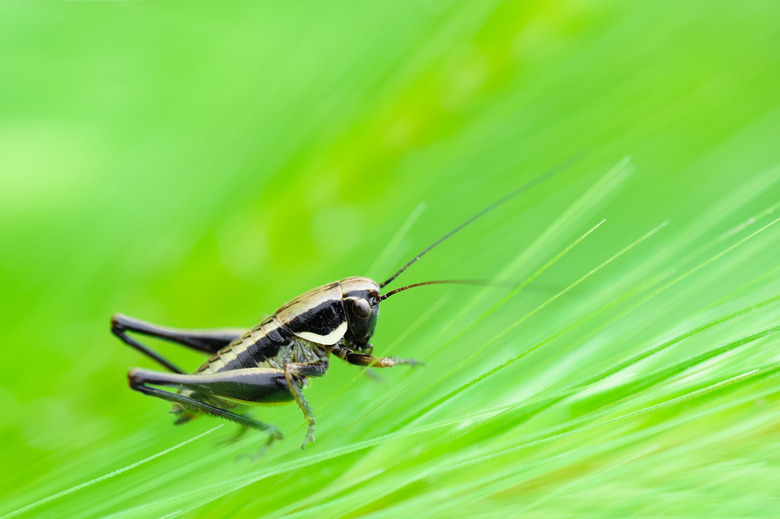How To Silence A Cricket
Lower temperatures and lack of water can stop a cricket from chirping, but when you hear it, you know love is afoot, because chirping is how crickets express it. Only the males do it, and they have different songs depending on whether they are trying to attract a female or trying to keep the females they have attracted happy. They even chirp to ward off competing males. Many people find the chirping pleasant, but it only happens at night, and it can wear on you when you're trying to sleep. It's difficult to track down a chirping cricket, because they are sensitive to movement and will stop chirping when you approach. Nevertheless, you can try a few tricks to get Romeo to quiet down.
TL;DR (Too Long; Didn't Read)
While it's impractical to hunt down a chirping cricket, you may be able to stop the chirping by lowering the temperature or setting out a bait. Keep crickets away by eliminating sources of food and moisture.
Introduce a Predator
Introduce a Predator
The first possibility isn't practical for most people, but it's an interesting option based on actual events on one of the Hawaiian islands. Residents of Kauai were regularly bothered by the boisterous activity of a species of cricket introduced from the western Pacific until a certain species of fly began stalking the crickets. The flies lay eggs in the crickets, and the larvae eat them from the inside. Male crickets were most vulnerable because their chirping made them easy to find, so they stopped. Gradually, the population mutated into a species that does not chirp, giving the story a happy end for all but the flies.
Eliminate Food and Moisture
Eliminate Food and Moisture
One way to quiet crickets is to encourage them to go somewhere else, and one sure way to do that is to eliminate all sources of water. Like all creatures, crickets need water to survive. One of the reasons they tend to hide in dark corners of basements is because there's moisture there. Turn up the heat or place a fan to evaporate the moisture, and the crickets will go away.
Besides moisture, crickets also need food, and their menu isn't sophisticated. They can survive on sawdust and glue if necessary. Make sure they can't get any nourishment by meticulously cleaning areas in which you suspect the chirping is coming from, and the crickets will go elsewhere.
Let Them Chill Out
Let Them Chill Out
Crickets are most active in warm temperatures, and thrive at about 80 or 90 degrees Fahrenheit. If you hear chirping coming from a particular room in your house, position a portable air conditioner in that room, lower the temperature and the chirping will probably stop. This may consume energy, but if the result is a good night's sleep for you, it's worth it.
Bait Them
Bait Them
A bowl of sticky-sweet material, such as maple syrup or molasses, may give you relief from a cricket's love song. If your nefarious scheme succeeds, the cricket will find the bait and get some on his wing, where it will interfere with the scraping mechanism that produces the sound. This plan isn't a sure bet, but it's easy to implement, and it might work.
Dealing with Crickets in Captivity
Dealing with Crickets in Captivity
Fisher-folk commonly keep crickets for bait, and an aquarium full of chirping crickets can be a distraction, to put it mildly. One strategy is to keep the aquarium illuminated at night and covered during the day so it stays dark. This could trick the insects into chirping during the day, when it won't affect your sleep. Another strategy is to lower the temperature until the crickets become too lethargic to chirp.
Cite This Article
MLA
Deziel, Chris. "How To Silence A Cricket" sciencing.com, https://www.sciencing.com/silence-cricket-6887211/. 22 November 2019.
APA
Deziel, Chris. (2019, November 22). How To Silence A Cricket. sciencing.com. Retrieved from https://www.sciencing.com/silence-cricket-6887211/
Chicago
Deziel, Chris. How To Silence A Cricket last modified March 24, 2022. https://www.sciencing.com/silence-cricket-6887211/
